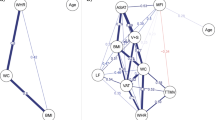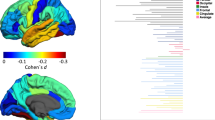Abstract
Background:
Body weight and adiposity are heritable traits. To date, it remains unknown whether obesity-associated brain structural alterations are under a similar level of genetic control.
Methods:
For this study, we utilized magnetic resonance imaging data from the Human Connectome Project. Voxel-based morphometry was used to investigate associations between body mass index (BMI) and regional gray matter volume (GMV) in a sample of 875 young adults with a wide BMI range (386 males/489 females; age 28.8±3.7 years; BMI 26.6±5.3 kg m−2) that included 86 pairs of monozygotic twins and 82 pairs of dizygotic twins. Twin data were analyzed by applying the additive genetic, common environmental and residual effects model to determine heritability of brain regions that were associated with BMI.
Results:
We observed positive associations between BMI and GMV in the ventromedial prefrontal cortex and the right cerebellum and widespread negative associations within the prefrontal cortex, cerebellum, temporal lobes and distinct subcortical structures. Varying degrees of heritability were found for BMI-associated brain regions, with the highest heritability estimates for cerebellar GMV and subcortical structures.
Conclusions:
These data indicate that brain regions associated with obesity are subject to differing levels of genetic control and environmental influences. Specific brain regions with high heritability might represent an inherent vulnerability factor for obesity.
This is a preview of subscription content, access via your institution
Access options
Subscribe to this journal
Receive 12 print issues and online access
$259.00 per year
only $21.58 per issue
Buy this article
- Purchase on Springer Link
- Instant access to full article PDF
Prices may be subject to local taxes which are calculated during checkout



Similar content being viewed by others

References
Ogden CL, Carroll MD, Kit BK, Flegal KM . Prevalence of childhood and adult obesity in the United States, 2011-2012. JAMA 2014; 311: 806–814.
Berridge KC, Ho C-Y, Richard JM, DiFeliceantonio AG . The tempted brain eats: pleasure and desire circuits in obesity and eating disorders. Brain Res 2010; 1350: 43–64.
Kenny PJ . Reward mechanisms in obesity: new insights and future directions. Neuron 2011; 69: 664–679.
Volkow ND, Wang G-J, Tomasi D, Baler RD . Obesity and addiction: neurobiological overlaps. Obes Rev 2013; 14: 2–18.
Horstmann A, Busse FP, Mathar D, Muller K, Lepsien J, Schlogl H et al. Obesity-related differences between women and men in brain structure and goal-directed behavior. Front Hum Neurosci 2011; 5: 58.
Janowitz D, Wittfeld K, Terock J, Freyberger HJ, Hegenscheid K, Völzke H et al. Association between waist circumference and gray matter volume in 2344 individuals from two adult community-based samples. Neuroimage 2015; 122: 149–157.
Kurth F, Levitt JG, Phillips OR, Luders E, Woods RP, Mazziotta JC et al. Relationships between gray matter, body mass index, and waist circumference in healthy adults. Hum Brain Mapp 2013; 34: 1737–1746.
Masouleh SK, Arélin K, Horstmann A, Lampe L, Kipping JA, Luck T et al. Higher body mass index in older adults is associated with lower gray matter volume: implications for memory performance. Neurobiol Aging 2016; 40: 1–10.
Pannacciulli N, Del Parigi A, Chen K, Le DSNT, Reiman EM, Tataranni PA . Brain abnormalities in human obesity: a voxel-based morphometric study. Neuroimage 2006; 31: 1419–1425.
Taki Y, Kinomura S, Sato K, Inoue K, Goto R, Okada K et al. Relationship between body mass index and gray matter volume in 1,428 healthy individuals. Obesity 2008; 16: 119–124.
Walther K, Birdsill AC, Glisky EL, Ryan L . Structural brain differences and cognitive functioning related to body mass index in older females. Hum Brain Mapp 2010; 31: 1052–1064.
Brooks SJ, Cedernaes J, Schiöth HB . Increased prefrontal and parahippocampal activation with reduced dorsolateral prefrontal and insular cortex activation to food images in obesity: a meta-analysis of fMRI studies. PLoS One 2013; 8: e60393.
Smucny J, Cornier M-A, Eichman LC, Thomas EA, Bechtell JL, Tregellas JR . Brain structure predicts risk for obesity. Appetite 2012; 59: 859–865.
Yokum S, Ng J, Stice E . Relation of regional gray and white matter volumes to current BMI and future increases in BMI: a prospective MRI study. Int J Obes 2012; 36: 656–664.
Elks CE, den Hoed M, Zhao JH, Sharp SJ, Wareham NJ, Loos RJF et al. Variability in the heritability of body mass index: a systematic review and meta-regression. Front Endocrinol 2012; 3: 29.
Hinney A, Vogel CIG, Hebebrand J . From monogenic to polygenic obesity: recent advances. Eur Child Adolesc Psychiatry 2010; 19: 297–310.
Loos RJF, Bouchard C . FTO: the first gene contributing to common forms of human obesity. Obes Rev 2008; 9: 246–250.
Stice E, Spoor S, Bohon C, Small DM . Relation between obesity and blunted striatal response to food is moderated by TaqIA A1 allele. Science 2008; 322: 449–452.
Ziauddeen H, Farooqi IS, Fletcher PC . Obesity and the brain: how convincing is the addiction model? Nat Rev Neurosci 2012; 13: 279–286.
Toga AW, Thompson PM . Genetics of brain structure and intelligence. Annu Rev Neurosci 2005; 28: 1–23.
Van Essen DC, Smith SM, Barch DM, Behrens TEJ, Yacoub E, Ugurbil K . The WU-Minn Human Connectome Project: an overview. Neuroimage 2013; 80: 62–79.
Van Essen DC, Ugurbil K, Auerbach E, Barch D, Behrens TEJ, Bucholz R et al. The Human Connectome Project: a data acquisition perspective. Neuroimage 2012; 62: 2222–2231.
Ashburner J, Friston KJ . Voxel-based morphometry–the methods. Neuroimage 2000; 11: 805–821.
Kringelbach ML . The human orbitofrontal cortex: linking reward to hedonic experience. Nat Rev Neurosci 2005; 6: 691–702.
Weise CM, Thiyyagura P, Reiman EM, Chen K, Krakoff J . Fat-free body mass but not fat mass is associated with reduced gray matter volume of cortical brain regions implicated in autonomic and homeostatic regulation. Neuroimage 2013; 64: 712–721.
Zhu J-N, Wang J-J . The cerebellum in feeding control: possible function and mechanism. Cell Mol Neurobiol 2007; 28: 469–478.
Veit R, Kullmann S, Heni M, Machann J, Häring H-U, Fritsche A et al. Reduced cortical thickness associated with visceral fat and BMI. Neuroimage Clin 2014; 6: 307–311.
Frank S, Kullmann S, Veit R . Food related processes in the insular cortex. Front Hum Neurosci 2013; 7: 499.
Weston CSE . Another major function of the anterior cingulate cortex: the representation of requirements. Neurosci Biobehav Rev 2012; 36: 90–110.
Mueller SG, Laxer KD, Cashdollar N, Buckley S, Paul C, Weiner MW . Voxel-based optimized morphometry (VBM) of gray and white matter in temporal lobe epilepsy (TLE) with and without mesial temporal sclerosis. Epilepsia 2006; 47: 900–907.
Wang GJ, Volkow ND, Logan J, Pappas NR, Wong CT, Zhu W et al. Brain dopamine and obesity. Lancet 2001; 357: 354–357.
Weise CM, Thiyyagura P, Reiman EM, Chen K, Krakoff J . A potential role for the midbrain in integrating fat-free mass determined energy needs: an H2 (15) O PET study. Hum Brain Mapp 2015; 36: 2406–2415.
Siep N, Roefs A, Roebroeck A, Havermans R, Bonte ML, Jansen A . Hunger is the best spice: an fMRI study of the effects of attention, hunger and calorie content on food reward processing in the amygdala and orbitofrontal cortex. Behav Brain Res 2009; 198: 149–158.
Rijsdijk FV, Viding E, De Brito S, Forgiarini M, Mechelli A et al. Heritable variations in gray matter concentration as a potential endophenotype for psychopathic traits. Arch Gen Psychiatry 2010; 67: 406–413.
Feng R, Zhou G, Zhang M, Zhang H . Analysis of twin data using SAS. Biometrics 2009; 65: 584–589.
White T, Andreasen NC, Nopoulos P . Brain volumes and surface morphology in monozygotic twins. Cereb Cortex 2002; 12: 486–493.
Thompson PM, Cannon TD, Narr KL, van Erp T, Poutanen V-P, Huttunen M et al. Genetic influences on brain structure. Nat Neurosci 2001; 4: 1253–1258.
Raschpichler M, Straatman K, Schroeter ML, Arelin K, Schlögl H, Fritzsch D et al. Abdominal fat distribution and its relationship to brain changes: the differential effects of age on cerebellar structure and function: a cross-sectional, exploratory study. BMJ Open 2013; 3, pii e001915.
Dimitropoulos A, Tkach J, Ho A, Kennedy J . Greater corticolimbic activation to high-calorie food cues after eating in obese vs. normal-weight adults. Appetite 2012; 58: 303–312.
Gearhardt AN, Yokum S, Stice E, Harris JL, Brownell KD . Relation of obesity to neural activation in response to food commercials. Soc Cogn Affect Neurosci 2014; 9: 932–938.
Tomasi D, Wang G-J, Wang R, Backus W, Geliebter A, Telang F et al. Association of body mass and brain activation during gastric distention: implications for obesity. PLoS One 2009; 4: e6847.
Tuulari JJ, Karlsson HK, Hirvonen J, Salminen P, Nuutila P, Nummenmaa L . Neural circuits for cognitive appetite control in healthy and obese individuals: an fMRI study. PLoS One 2015; 10: e0116640.
Buckner RL . The cerebellum and cognitive function: 25 years of insight from anatomy and neuroimaging. Neuron 2013; 80: 807–815.
Strick PL, Dum RP, Fiez JA . Cerebellum and nonmotor function. Annu Rev Neurosci 2009; 32: 413–434.
Burger KS, Stice E . Greater striatopallidal adaptive coding during cue–reward learning and food reward habituation predict future weight gain. Neuroimage 2014; 99: 122–128.
Small DM . Individual differences in the neurophysiology of reward and the obesity epidemic. Int J Obes 2009; 33: S44–S48.
Mueller K, Möller HE, Horstmann A, Busse F, Lepsien J, Blüher M et al. Physical exercise in overweight to obese individuals induces metabolic- and neurotrophic-related structural brain plasticity. Front Hum Neurosci 2015; 9: 372.
Prehn K, Jumpertz von Schwartzenberg R, Mai K, Zeitz U, Witte AV, Hampel D et al. Caloric restriction in older adults-differential effects of weight loss and reduced weight on brain structure and function. Cereb Cortex 2016. e-pub ahead of print 1 February 2016 pii bhw008.
Tuulari JJ . Effects of obesity and weight loss following bariatric surgery on brain function structural integrity and metabolism, 2015. Available at www.doria.fi.
Acknowledgements
Data were provided (in part) by the Human Connectome Project, WU-Minn Consortium (Principal Investigators: David Van Essen and Kamil Ugurbil; 1U54MH091657) funded by the 16 NIH Institutes and Centers that support the NIH Blueprint for Neuroscience Research and by the McDonnell Center for Systems Neuroscience at Washington University. This study was supported by the IFB AdiposityDiseases, Federal Ministry of Education and Research (BMBF), Germany, FKZ: 01E01001 (http://www.bmbf.de) and the German Research Foundation (DFG; http://www.dfg.de), within the framework of the CRC 1052 Obesity Mechanisms to Project A6 (to BP).
Author information
Authors and Affiliations
Corresponding author
Ethics declarations
Competing interests
The authors declare no conflict of interest.
Additional information
Supplementary Information accompanies this paper on International Journal of Obesity website
Supplementary information
Rights and permissions
About this article
Cite this article
Weise, C., Piaggi, P., Reinhardt, M. et al. The obese brain as a heritable phenotype: a combined morphometry and twin study. Int J Obes 41, 458–466 (2017). https://doi.org/10.1038/ijo.2016.222
Received:
Revised:
Accepted:
Published:
Issue Date:
DOI: https://doi.org/10.1038/ijo.2016.222
This article is cited by
-
Viscoelasticity of striatal brain areas reflects variations in body mass index of lean to overweight male adults
Brain Imaging and Behavior (2020)
-
Prefronto-cerebellar neuromodulation affects appetite in obesity
International Journal of Obesity (2019)
-
Neuroanatomical differences in obesity: meta-analytic findings and their validation in an independent dataset
International Journal of Obesity (2019)
-
Preliminary evidence for genetic overlap between body mass index and striatal reward response
Translational Psychiatry (2018)


